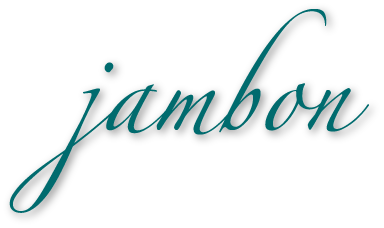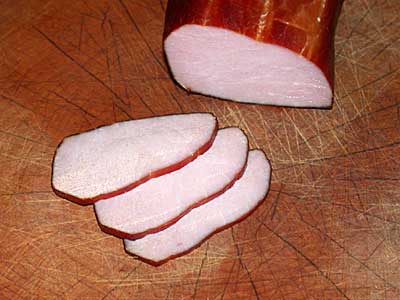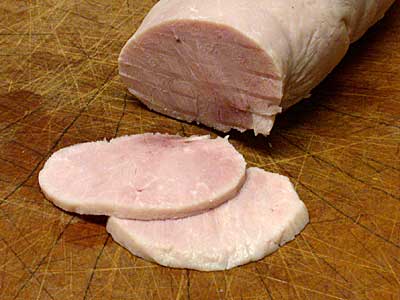The preservation of meat with salt and nitrate is an old practice performed in many countries around the world. Before the invention of refrigeration, preserving meat with these ingredients was a necessity of life. Nowadays, it is done to obtain the unique flavor and texture only obtainable by applying the technique of preservation.
One popular form of preserved meat in France—jambon (ham)—is now rarely cured in a traditional manner which allows it to be stored without refrigeration. The degree of curing used today is much lighter than in the old days, and the jambon can now be eaten without further treatment. (It will also spoil quicker.) An old-style jambon cured to the point where it can be stored without refrigeration usually requires soaking to remove some of the excess saltiness before it can be cooked and comfortably eaten.
Depending upon the specific method of preservation used, jambons are cured in either dry salt or a salt brine. Following curing, the jambon is either dried or cooked. Traditionally, families would hang the cured jambon high in their fireplace chimney to gently smoke for a couple of weeks. In the low temperature (less than 30 °C, or 90 °F) chimney smoke, the jambon would partially dry and take on the subtle flavor of the wood. Further drying was carried out in an area with both low temperature and humidity, often a north-facing room that was semi-open to the outside elements. Smoke dried jambons, such as jambon de Bayonne, are thinly sliced for eating and are technically still raw.
Cooked jambons are cooked either by poaching or smoking. Modern jambons are most likely to be poached after curing, such as a jambon de York. Poaching cooks the jambon thoroughly, but the meat is still moist since it is finished when the internal temperature reaches about 75 °C (165 °F). At this temperature the meat is cooked but not dry. Commercial jambons may also be smoked for flavor before poaching, although the smoky flavor may actually come from liquid smoke injected along with the brine during curing.
In today’s world of hypermarchés and fast food, French farmers rarely produce their own jambon. The process is left to local charcuteries and mass production factories. This is unfortunate since the process is both straight forward and simple. Although it takes a number of days to make a jambon at home, very little hands-on time is actually required on each of those days. The main problem for the home cook attempting to make their own jambon is space. The hind leg of a full grown pig requires more space for curing and finishing than most of us have in our homes. One solution to the lack of space is to make jambon from a cut of meat smaller than the leg. My preference is the longe, or loin. This is a long muscle that runs along the back of the pig. It works perfectly for making jambon in a small home.
To make jambons at home, the loins are cured for about three days in a brine made from salt, nitrite, and flavorings. At this point the jambon can either be poached, or dried overnight and smoked. In either case, the internal temperature of the meat is elevated just to 75 °C (165 °F) so the meat is fully cooked in the finished jambon.
The following recipes for petit jambon au torchon (a small ham cooked in a towel) and petit jambon fumé (a small smoked ham) illustrate how simple it is to prepare jambon at home. Both methods start in the same manner…


























